Related Research Articles

Yorkshire, formally known as the County of York, is a historic county of Northern England and the largest in the United Kingdom. Because of its great size in comparison to other English counties, functions have been undertaken over time by its subdivisions, which have also been subject to periodic reform. Throughout these changes, Yorkshire has continued to be recognised as a geographic territory and cultural region. The name is familiar and well understood across the United Kingdom and is in common use in the media and the military, and also features in the titles of current areas of civil administration such as North Yorkshire, South Yorkshire, West Yorkshire and the East Riding of Yorkshire.

Lancashire is a ceremonial county and geographical area in North West England. The ceremonial county's administrative centre is Preston, while Lancaster is still the county town. The borders of the ceremonial county were created by the Local Government Act 1972 and enclose a population of 1,449,300 and an area of 1,189 square miles (3,080 km2).

Yorkshire and the Humber is one of nine official regions of England at the first level of Nomenclature of Territorial Units for Statistics (NUTS) for statistical purposes. It comprises most of Yorkshire, as well as North Lincolnshire and North East Lincolnshire. Middlesbrough, Redcar and Cleveland or other areas of the historic county of Yorkshire, are not included. The largest settlements are Leeds, Sheffield, Bradford, Hull, and York. The population in 2011 was 5,284,000.
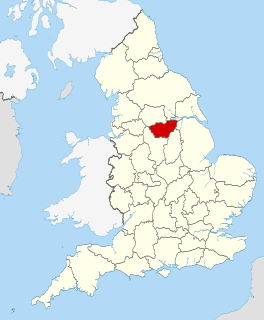
South Yorkshire is a ceremonial county and metropolitan county in England. It is the southernmost county in the Yorkshire and the Humber region and had a population of 1.34 million in 2011. It has an area of 1,552 square kilometres (599 sq mi) and consists of four metropolitan boroughs, Barnsley, Doncaster, Rotherham and Sheffield. South Yorkshire was created on 1 April 1974 as a result of the Local Government Act 1972. Its largest settlement is Sheffield.

North Yorkshire is the largest non-metropolitan county and lieutenancy area in England, covering an area of 8,654 square kilometres (3,341 sq mi). Around 40% of the county is covered by national parks, including most of the Yorkshire Dales and the North York Moors. It is one of four counties in England to hold the name Yorkshire; the other three are the East Riding of Yorkshire, South Yorkshire and West Yorkshire.
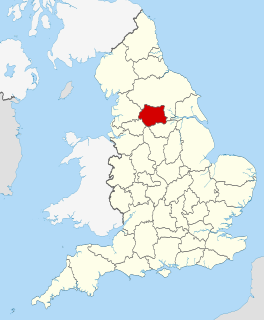
West Yorkshire is a metropolitan and ceremonial county in England. It is an inland and, in relative terms, upland county having eastward-draining valleys while taking in the moors of the Pennines. West Yorkshire came into existence as a metropolitan county in 1974 after the passage of the Local Government Act 1972 and has a population of 2.3 million.

Wakefield is a cathedral city in the City of Wakefield District of West Yorkshire, England, on the River Calder and the eastern edge of the Pennines, which had a population of 99,251 at the 2011 census.

The East Riding of Yorkshire, or simply East Riding or East Yorkshire, is a county in Northern England. The name is traditionally and geographically a reference to the easternmost of the three subdivisions of the traditional county of Yorkshire. The boundaries of the East Riding, the North Riding and the West Riding were historically treated as three separate areas for many cultural and legal purposes, such as having separate quarter sessions. In 1889 under the Local Government Act 1888, administrative counties were formed on the existing historic county boundaries in England, but in Yorkshire, given the vast size of the county area, three administrative county councils were created, based on the historic boundaries of the three Ridings. The East Riding County Council was the administrative local government and ceremonial county (Lieutenancy) area established for the area ; it remained in place for eighty-six years until being removed for new administrative tiers of local government.

Whitby is a seaside town, port and civil parish in the Scarborough borough of North Yorkshire, England. Situated on the east coast of Yorkshire at the mouth of the River Esk, Whitby has a maritime, mineral and tourist heritage. Its East Cliff is home to the ruins of Whitby Abbey, where Cædmon, the earliest recognised English poet, lived. The fishing port emerged during the Middle Ages, supporting important herring and whaling fleets, and was where Captain Cook learned seamanship. Tourism started in Whitby during the Georgian period and developed with the arrival of the railway in 1839. Its attraction as a tourist destination is enhanced by the proximity of the high ground of the North York Moors national park and the heritage coastline and by association with the horror novel Dracula. Jet and alum were mined locally, and Whitby jet, which was mined by the Romans and Victorians, became fashionable during the 19th century.
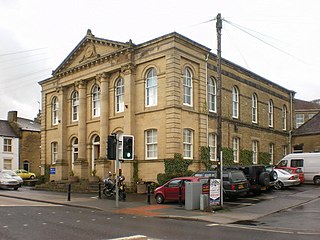
Craven is a local government district of North Yorkshire, England centred on the market town of Skipton. In 1974, Craven district was formed as the merger of Skipton urban district, Settle Rural District and most of Skipton Rural District, all in the West Riding of Yorkshire. The population of the Local Authority at the 2011 Census was 55,409. It comprises the upper reaches of Airedale, Wharfedale, Ribblesdale, and includes most of the Aire Gap and Craven Basin.

The North Riding of Yorkshire is one of the three historic subdivisions (ridings) of the English county of Yorkshire, alongside the East and West ridings. From the Restoration it was used as a lieutenancy area, having been previously part of the Yorkshire lieutenancy. The three ridings were treated as three counties for many purposes, such as having separate quarter sessions.

Bridlington, a coastal town and civil parish on the Holderness Coast of the North Sea, nicknamed the "Lobster Capital of Europe", belongs to the unitary authority and ceremonial county of the East Riding of Yorkshire. It is about 28 miles (45 km) north of Hull and 34 miles (55 km) east of York. The Gypsey Race enters the North Sea at its harbour. The 2011 Census gave a parish population of 35,369. As a minor sea-fishing port, it is known for shellfish. Bridlington is the largest lobster port in the UK and Europe, with over 300 tonnes of the crustaceans being landed there each year. Alongside small manufacturing, retail and service firms, its main trade is summer tourism. It is twinned with Millau, France, and Bad Salzuflen, Germany. It holds one of the UK's coastal weather stations. The Priory Church of St Mary and associated Bayle Gate are Grade I listed buildings on the site of an Augustinian Priory.

Northallerton is a market town and civil parish in the Hambleton district of North Yorkshire, England. It lies in the Vale of Mowbray and at the northern end of the Vale of York. It had a population of 15,741 according to the 2001 census, which had risen to 16,832 in 2011. It has served as the county town of the North Riding of Yorkshire and since 1974, of North Yorkshire. Northallerton is made up of four wards, North, Broomfield, Romanby and Central.

County Durham is a ceremonial county in North East England. The county town is Durham, a cathedral city. During the Middle Ages, the county was an ecclesiastical centre, due largely to the presence, of St Cuthbert's shrine in Durham Cathedral, and the extensive powers granted to the Bishop of Durham as ruler of the County Palatine of Durham.

The Borough of Stockton-on-Tees, commonly called Stockton Borough, is a local authority borough, a part of County Durham, North Yorkshire and Tees Valley, in Northern England. The main town is Stockton, which on the north bank of the River Tees. The town and borough have a population of 82,880 and 191,600, both shown in the 2011 census.

Yorkshire County Cricket Club is one of eighteen first-class county clubs within the domestic cricket structure of England and Wales. It represents the historic county of Yorkshire. The club's limited overs team is called the Yorkshire Vikings. Yorkshire teams formed by earlier organisations, essentially the old Sheffield Cricket Club, played top-class cricket from the 18th century and the county club has always held first-class status. Yorkshire have competed in the County Championship since the official start of the competition in 1890 and have played in every top-level domestic cricket competition in England.

Brigg and Goole is a constituency in Yorkshire and Lincolnshire represented in the House of Commons of the UK Parliament since 2010 by Andrew Percy, a Conservative.
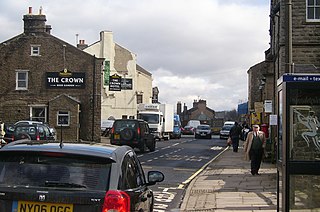
Hawes is a small market town and civil parish in the Richmondshire district of North Yorkshire, England, at the head of Wensleydale in the Yorkshire Dales, and historically in the North Riding of Yorkshire. The River Ure north of the town is a tourist attraction in the Yorkshire Dales National Park.
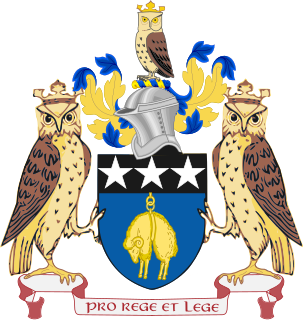
The City of Leeds is a city and metropolitan borough in West Yorkshire, England. The metropolitan borough includes the administrative centre of Leeds and the towns of Farsley, Garforth, Guiseley, Horsforth, Morley, Otley, Pudsey, Rothwell, Wetherby and Yeadon. It has a population of 793,139 (mid-2019 est.), making it technically the second largest city in England by population behind Birmingham. It is governed by Leeds City Council.
Tourism in Yorkshire generates more than £9 billion per annum and supporting almost 225,000 jobs. During 2007 recorded 92 million day visitors and 12.8 million that stayed at least one night in the region. By 2015, the value of tourism was in excess of £7 billion.